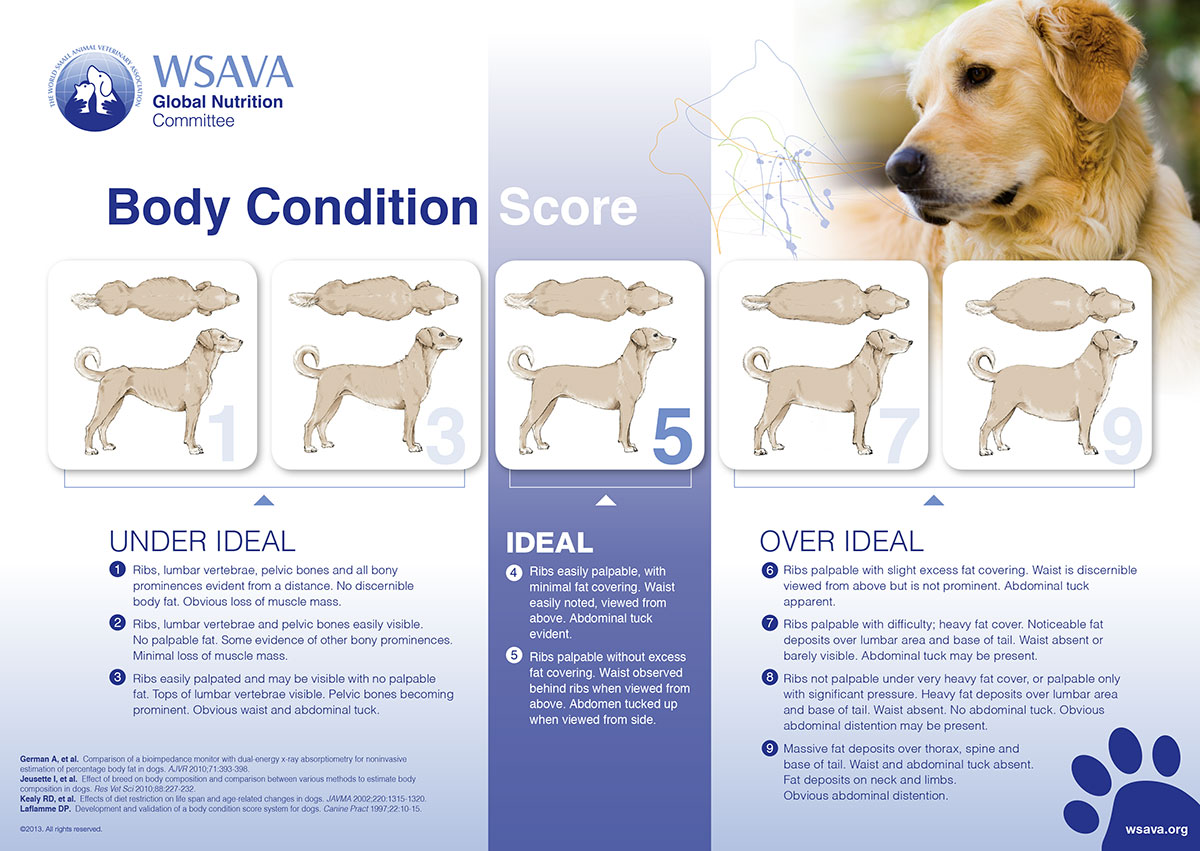Weight Management
There is undisputed evidence in human and veterinary medicine that carrying too much body weight is not good for arthritis or health in general.
Achieving ideal body weight is a ‘no brainer’ when it comes to managing arthritis.
Excess body weight increases the mechanical forces that joints are subjected to which will exacerbate pain and the degenerative disease. Fat, also known as adipose tissue, contains inflammatory mediators that also aggravate arthritic pain, as well as having a significant impact on the rest of the body.
If your dog is overweight, weight loss will have a significant positive impact on the pain of arthritis and will slow the progression of the disease. Studies have shown that losing 6% of excess body weight will significantly reduce an arthritic dog’s lameness.
Following breed guidelines regarding ideal body weight is not unfortunately not accurate. There are huge variations in body structure within a breed. A targeted assessment of actual body weight with consideration of a dog’s frame can be obtained through body condition scoring.
This simple hands on assessment tool will immediately tell you if your dog is airing on the heavy side.
In addition to learning to body condition score, as above, you can access low cost or even free weight management advice with trained and qualified members of staff at your local veterinary practice. They will be able to tailor their advice to your dog and your lifestyle.
It is easier to prevent weight gain than it is to shed the pounds. So if your dog is a lean machine now, still learn to body condition score so that you can keep them that way.

Provided courtesy of the World Small Animal Veterinary Association (WSAVA). Available at the WSAVA Global Nutrition Committee Nutritional Toolkit website. Accessed July 2021.

for effective weight control
- Look at what you feed, how much you feed and how you feed it.
Consider their body condition score as well as their age, breed and activity levels and choose a diet to suit.
Remember a dog with arthritis may be exercising a lot less which will mean their calorie intake needs to be reduced accordingly.
There are many strong opinions about diets, which can be daunting for a dog owner to navigate. Currently evidence supports the following advice:- With regards finding the ‘best’ diet, there is no evidence to suggest one style of diet is superior to another.
- Emphasis is on attaining an ideal body weight which can be achieved through different diets and different regimes.
- Evidence supports adding omega 3 fatty acids to an arthritic dog’s diet. However, the effective dose is quite high which can lead to weight gain and diarrhoea. Therefore choosing a diet with the omega 3 content already formulated within may be safer and easier.
- Consider the use of interactive or slow feeding toys which can help make meal times longer and more fun for your dog reducing the pressure from begging and pleading eyes.
- Leave one person in the household in charge of feeding to ensure consistency in the routine and quantity.
- Weigh the food on digital scales to ensure your dog’s portion is accurate. If time is short and the type of food allows it, you may be able to portion their daily diet into small containers so that you have a pre-set portion of food available for each meal time.
- Remove temptation and hide away all the dog treats.
- Consider occupying your dog out of sight while you eat to remove the temptation to give them table scraps.
- Don’t allow them to lick plates, bowls and the content of the dishwasher, it will all add up to excess calorie intake.
- Discourage friends, colleagues and other dog walkers from offering your dog treats.
- Regularly weigh your dog at home or at your veterinary clinic and keep a record of their weight. A simple way to check their weight at home is to weigh yourself on digital bathroom scales, then weigh yourself holding your dog (assuming they are small enough to safely lift). Through subtracting your weight from the total weight of you plus your dog, you can work out their weight.
- With consideration of their general health and comfort, introduce and very slowly increase the amount of exercise they do. Suddenly increasing the lengths or difficulty of their walks is dangerous because their body’s are not ready for it. Exercise is not a big fat burner, so reducing calorie intake is more effective at shifting weight. However, exercise will improve their muscular and cardiovascular fitness, as well as contributing to their emotional well being.

FAT IS LIKE PETROL ON AN ARTHRITIC FIRE

